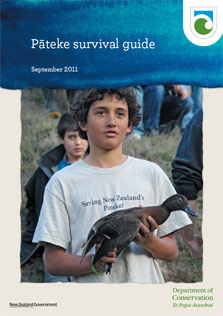Past Releases
Efforts to re-establish Brown Teal populations by releasing captive reared birds first started in 1968 when the NZ Wildlife Service released 10 pairs of Brown Teal onto Kapiti Island. These birds were a mixture of both captive reared and wild caught birds. Some thirty years on Kapiti Island still supports a small number of Brown Teal. The population was given a boost in 2001 when a further ten pairs were released onto Kapiti Island.
Over recent years successful breeding of captive reared Brown Teal released into Moehau, Tawhanui, Cape Kidnappers, Tutukaka have been confirmed.
Between 1977 and 1983 – 320 Brown Teal reared by Ducks Unlimited members were released onto coastal lagoons in the Manawatu area of New Zealand. These birds adapted well to the wild and successful breeding was recorded on a number of occasions, but with widespread duck hunting in the area, together with a whole suite of predators to contend with, this population also declined. There are, however, still regular sightings of Brown Teal frequenting the Waikanae Estuary, which is on the mainland opposite Kapiti Island.
We now appreciate that nothing whatever had been done in the Manawatu to reduce or eliminate the reasons why the original Brown Teal in the area, which were once present in vast numbers, had disappeared. But in those days everyone was on a learning curve and in 1983 it was decided to try another area in the North Island with a release of captive reared birds. This was on Matakana Island in the Bay of Plenty, where 64 teal were released, but this too was not a success and a decision was made in 1984 to move the release programme to Northland, in an effort to stabilise the declining Northland population.
A considerable amount of Brown Teal habitat protection, creation and enhancement work had been carried out in Northland by the NZ Wildlife Service and from 1984-89 a total of 494 captive reared Brown Teal were released onto five different wetlands in Northland. In those days technology was not available to easily and cost effectively monitor released birds with radio transmitters, so the success of the releases could not really be measured.
On-site pre-release holding aviaries were erected at two sites and various experiments took place in an effort to determine the best release technique and what was the most suitable time of the year to release the birds, but no conclusions were reached.
The totals of Brown Teal released into the wild between 1978 and 2001 were just over 1,500, with close to 1,000 of these being released into Northland.
In Northland none of these Brown Teal were released into areas where Brown Teal still survive and only in four instances have they been released into areas recently vacated by Brown Teal.
From the release exercises up to the year 1997 it would be very easy for a conclusion to be reached that – no-one really knows what they are doing! That may well be true, but a lot of good people where trying to create miracles without a lot of money or support.
It is now encouraging that currently there is certainly a more cohesive approach to releases being taken which is based on sound science, so at least we can find out exactly where we need to improve. Birds are now only released into either predator minimised or predator free areas, and a representative sample are transmittered and monitored to now truly understand what is happening once your captive babies once released.
Between 2003 – 2013 our average survival of released birds into the wild 12 months post release have achieved an average of 70% survival, which is an awesome result

